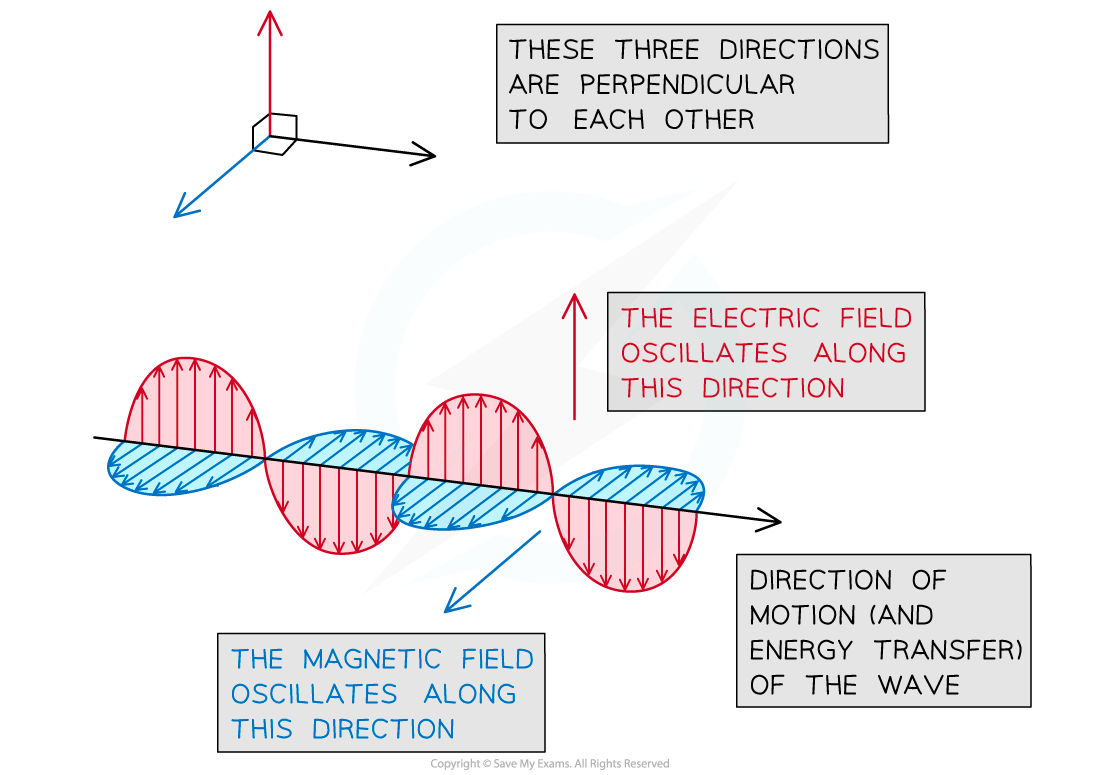Electromagnetic Waves (DP IB Physics) : Revision Note
The Electromagnetic Spectrum
An electromagnetic wave is generated by the combined oscillation of an electric and a magnetic field
These fields oscillate perpendicularly to each other and to the direction of motion of the wave (i.e. the direction in which energy is transferred)

An electromagnetic wave is generated by the combined oscillation of an electric and a magnetic field
Electromagnetic waves are transverse waves and, as such, they can travel through vacuum
Regardless of their frequency, all electromagnetic waves travel at the speed of light c = 3 × 108 m s–1 in vacuum
Electromagnetic waves form a continuous spectrum based on their frequency (or wavelength)
The shorter the wavelength, or higher the frequency, the greater the energy of the wave

The electromagnetic spectrum
Humans can only sense electromagnetic waves with wavelengths in the range 700 nm - 400 nm, which are the limits of the so-called visible spectrum
Electromagnetic waves with longer and shorter wavelengths are invisible to the human eye
Knowing the wavelengths of electromagnetic waves, their frequencies can be calculated using
The wave equation
The fact that the speed of light (c = 3 × 108 m s–1) in a vacuum is constant
Worked Example
The wavelength of blue light falls within the range 450 nm – 490 nm.
Determine the range of frequencies of blue light.
Answer:
Step 1: Write down the known quantities
Note that you must convert the values of the wavelength from nanometres (nm) into metres (m)
λlower = 450 nm = 4.5 × 10–7 m
λhigher = 490 nm = 4.9 × 10–7 m
Step 2: Remember that all electromagnetic waves travel at the speed of light in vacuum
From the data booklet, c = 3.00 × 108 m s–1
Step 3: Write down the wave equation
Step 4: Rearrange the above equation to calculate the frequency f
Step 5: Substitute the lower and higher values of the wavelength to calculate the limiting values of the frequency of blue light
The lower frequency flower corresponds to the higher value of the wavelength λhigher
The higher frequency fhigher corresponds to the lower value of the wavelength λlower
Step 6: Write down the range of frequencies of blue light
Examiner Tips and Tricks
You don't need to memorise the order or the wavelengths of waves in the electromagnetic spectrum, as this is given in your data booklet. However, you must remember all electromagnetic waves travel at the speed of light, c.
Comparing Mechanical & Electromagnetic Waves
Travelling waves can be of two types, mechanical and electromagnetic
Mechanical Waves | Electromagnetic Waves |
Require a medium, such as a fluid or solid to propagate through | Do not require a medium |
Can be transverse or longitudinal | Are only transverse |
Cannot travel through a vacuum | Can travel through a vacuum |
Are produced by the oscillation of particles in a medium | Are produced by oscillating charged particles |
Examples: Sound waves, waves on the surface of the ocean | Examples: Radio waves, UV rays, X-rays |
Travel a lot slower than the speed of light | Travel at the speed of light |

Electromagnetic waves can travel in a vacuum (such as space) whilst mechanical waves require a medium (such as water)
Examiner Tips and Tricks
You must be able to identify the features of either mechanical or electromagnetic waves, depending on the question.
A common misconception is that mechanical waves are just longitudinal, like sound waves. However, they can also be transverse waves that travel through a medium such as seismic waves (created during an earthquake) and water waves.

You've read 0 of your 5 free revision notes this week
Sign up now. It’s free!
Did this page help you?
